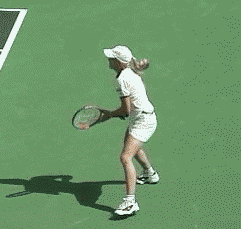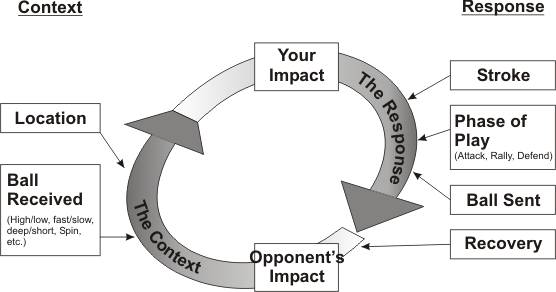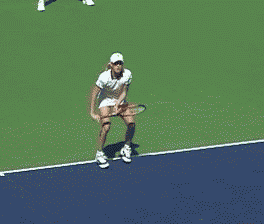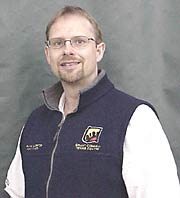|
TennisOne Lessons
Game-Based Situation Training--Learning the Language Wayne Elderton In recent years, the language of technique has become more familiar to players and coaches alike. Talk about rotation, balance, angular momentum, loading, etc. is common. With the ‘sports science revolution', technique is now handled in a very systematic and logical way. The language of tactics is not as developed. Sure, everyone knows about attacking verses being neutral, inside-out shots, and keeping the ball deep, etc. But these concepts tend to float around in a player's head disconnected to their development. The reason is, that WHEN you select these things is the basis of playing the game. Playing is a tactical endeavor. Tactics involves problem-solving (what do I do when my opponent comes to the net?), and decision-making (should I pass with a lob, crosscourt dip, or down-the-line drive?) Decision-making is every bit as important as technique. Actually, decision-making is the basis of technique since even the most unskilled beginner must decide where, when, and how to hit a shot. One cannot use their one-size-fits-all backhand groundstroke technique, receive different types of balls (high, wide, deep, etc.), and consistently hit the ball to the same place. In other words, all strokes must adapt. The quote I like is from coaching and management guru, Peter Burwash: “Tennis is a series of constant dire emergencies.”
Contrary to what T.V. commentators say (“no one can learn that skill, you have to be born with it”), decision-making is very trainable if one knows how. Because of not knowing how, coaches and players opt to just ignore it. The result, players moving along a slow learning curve of trial and error hoping that if they play enough, one day they may ‘get it'. I have observed a funny phenomenon at many sports events (not just tennis). The players spend vast amounts of time practicing technical skills (e.g. dribbling and passing in soccer). Is that what you hear the coaches complaining about from the sidelines? Sometimes yes, but more often, they comment about their choices (“Don't pass it that direction! Take #22 not the other guy! Why didn't you lob him? Don't serve to his forehand!”). Why get mad at poor choices when no one has been trained to make good decisions? I have found that 40-60% of all errors in tennis can be classified as decision-making errors. Improving your decision-making can dramatically improve your tennis. Tennis talk is dominated by ‘stroke language'. For a more Game-based way to look at tennis (see my first two articles in the TennisOne Lesson Library), we can describe tennis in more tactical terms. Not that strokes are a bad thing, they just limit the picture we have of the game. The tactical/technical connection is lost when players focus on stroke technique alone. Stop Practicing Strokes The best way I have found to tie together tactics, techniques, problem-solving, and decision-making, is by what I call, Situation Training. Before we get into Situation Training, we need to learn the language. It's a different way to talk about and view the game, but once you get the hang of it, a whole new world of tennis possibilities opens up. Rather than talking about strokes, which draws players away from tactics, it is more helpful to think of Shots. Stroke, shot, what's the difference? I define a shot as a cycle of events that start with the ball a player is receiving, the stroke they hit, and the recovery for the next shot. More accurately, I call it a “Shot Situation.” This Shot Situation includes some key events. Diagram #1 shows the cycle. It can start from your impact (like on a serve), or your opponent's impact. While we often talk about strokes, it is theses Shot Situations that are the building blocks of the tactical game. Shots add up to points, points to games, games to sets, and sets to matches.
As seen on the diagram above, this Shot Situation is comprised of two critical phases: The Context: This describes all tactical elements that affect the player when receiving the shot (e.g. Where they are? Where their opponent is? What kind of ball they are receiving?) The context presents a challenge to the player (e.g. a high lob over your head when you are at net, a weak, short ball at midcourt). By becoming familiar with the possible contexts you encounter when playing tennis, you develop your Tactical Awareness. The Response: This includes the stroke, the Phase of play (attack, neutral, defend), the ball sent, and where to recover. It is the solution to the challenge the context presents. Creating responses establishes your Tactical Intentions.
These two tactical skills (awareness of what's going on, and having a clear intention) are the two elements I find most lacking in technically focused players. The goal is not to practice strokes but train Shot Situations to increase your ‘library' of contexts and good responses. For example, rather than describing your backhand as having trouble (Which backhand, since there are many?), you could use the Shot Situation terminology. Let's look at clip #2 of a Justine Henin-Hardenne Backhand Shot Situation: “In a BASELINE (Location) rally, my opponent was DEEP BEHIND their BASELINE (their location) and they sent a HIGH BALL with TOPSPIN to my BACKHAND (Ball received).” The challenge is to avoid sending the ball back weak and short in the middle and give my opponent a chance to attack. To solve this, I must: “SLICE a DEEP BALL back (Ball sent) to NEUTRALIZE them (Phase of Play) and REMAIN BACK IN A DEFENSIVE POSITION (Recovery) to maintain a rally.”
An exercise in Situation Training When you play, make a list of the situations you are finding problematic. Identify 3-5 situations that occur repeatedly (e.g. I am always having trouble with low balls at my feet when I come to net, I have trouble with wide serves that slice to my forehand on the deuce side). Next, by thinking about it yourself, asking a coach, or watching players on TV, figure out a successful response to your problematic situation. Remember, successful doesn't mean to win the point. If you are in a defensive situation and get the ball back in a way the opponent couldn't attack you again, that is successful! Here is a sample of a Shot Situation table you can make to help organize your thoughts. Watch clip #3 of Justine and see how it looks broken down: SHOT SITUATION: Justine Henin-Hardenne
Post Test When we get to other articles in this series with specific Situation Training lessons, this language and these terms are key to your understanding and improvement. Take this little post-test to check your understanding: Define these terms:
Thinking about your game in these terms sets the stage for meaningful tactical/technical development. Good decision-making and winning more matches is just around the corner. Good luck in your Game-based, Situation Training journey. For more information on the Game-based approach, you can visit Wayne Elderton's website at www.acecoach.com
|
||||||||||||||||||||||||||||





 Wayne Elderton
Wayne Elderton